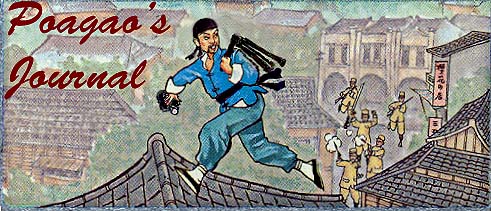Their Way
 I was planning to meet Chenbl later yesterday at Jiantan, so instead of getting my usual salmon bento to take back to the Water Curtain Cave for consumption, I had a pleasant sandwich/coffee/carrot cake combo at the Metro Cafe on Chongqing South Road. As it does just about every day in summer, the weather went from bright sun to threatening skies during the course of my meal, so I went back to my office to get an umbrella, planning to take the subway up to Jiantan to have a look around before meeting up with Chenbl after he got off work.
I was planning to meet Chenbl later yesterday at Jiantan, so instead of getting my usual salmon bento to take back to the Water Curtain Cave for consumption, I had a pleasant sandwich/coffee/carrot cake combo at the Metro Cafe on Chongqing South Road. As it does just about every day in summer, the weather went from bright sun to threatening skies during the course of my meal, so I went back to my office to get an umbrella, planning to take the subway up to Jiantan to have a look around before meeting up with Chenbl after he got off work.
The sound of singing that was entirely too awful to be a recording, however, drew me to the square in front of Zhongshan Hall, where a large group of mostly elderly people huddled under tents as rain began to pelt down. Most of them were wearing vests sporting various military-themed logos, and they seemed to all know each other. The songs being sung were old-timey patriotic/nationalist songs (plus the first part of Frank Sinatra’s “My Way” with the phrase “the final curtain” replaced by “the final battle”(!), and even more disturbing: Engelbert Humperdinck’s “Please Release Me”); the KMT was in heavy presence, as were various police officers, obviously armed, with one sporting a clump of white zip ties on her belt. I didn’t know what they were expecting; there were no counter protesters and hardly any media around.
They held a ceremony consisting of people lining up to lay yellow flowers on the “Monument to the Victory of the Anti-Japanese War and the Restoration of Taiwan” plaque opposite the hall. Several speeches were made conveying the disturbing message that the “real enemy” was the DPP, not the CCP. A Buddhist monk spoke, as well as various KMT officials. I walked around the edges of the crowd, taking a few photos but not daring to get too close as entirely too many of the old people were maskless and sitting clumped together under the tents. A few of them gave me some strange looks but mostly I was left alone as they probably assumed I was just some random tourist. It all felt a little sad and desperate, the last gasps of a disappearing world. But it would be dangerous to discount this demographic; although they are diminishing in numbers, especially due to covid, they still wield substantial financial and political power.
“Are you a photographer?” an unmasked Asian American man who looked to be in his 40’s asked me. As always, I didn’t know how to answer that question, but he wasn’t concerned with my lack of a definitive answer. He was, he said, a YouTuber, and a quite well known one at that, focusing on political analysis of both the U.S. and Taiwan. I didn’t contribute much to the conversation, mostly listening and nodding at his rather, uh…unconventional views. He stressed, with no prompting, that he wasn’t a fan of Trump, though I hadn’t asked or even mentioned Trump. That always strikes me as odd. But when he was talking about the “mystery” of Republicans gaining ground in Florida, I couldn’t help but ask if perhaps DeSantis’ agenda had been having an effect. “Who?” he asked, puzzled.
“Ron DeSantis?”
“I don’t know who that is.”
“The governor of Florida,”
“Oh, I don’t know who any of those people are,” he said, dismissing such knowledge as unimportant. The real issue, he said, was the DPP stuffing ballot boxes. I asked if he had participated in the voting process here, but again, no, he wasn’t a citizen; his source was…and you might want to sit down for this…a mysterious friend with connections to U.S. intelligence. I only hope I haven’t said too much.
The sun had come out again at this point, and Chenbl said he was on his way, so I caught the subway up to Jiantan. While Chenbl got his hair cut, I walked over to the river and spotted a nice puddle that would surely, I judged from the top of the flood wall, reflect the sunset and skyline. As I approached, another man approached from the opposite direction, a large DSLR around his neck. Surely he will see that reflection, I thought, so I adjusted my path to let him approach it first, but he didn’t. When I crouched down to get my shot, however, I heard the clack of his shutter and looked up to see him photographing me. So if you see a photograph of me crouching by a puddle, 1) this is probably what I was doing, and 2) this is not a rare thing for me. My fellow BME member Don Hudson always points this out, and I am not ashamed of my inability to resist the attraction of a reflective surface. I’ve been doing this shit since the Mirror Project of yore and even before, and I don’t plan on stopping.






